


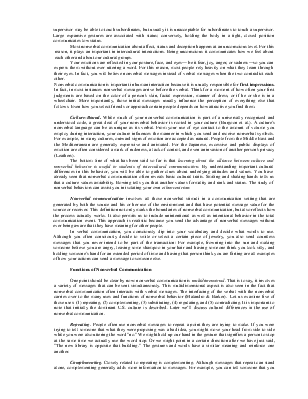










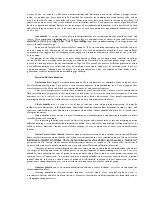








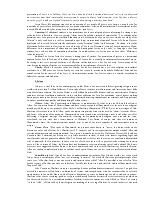



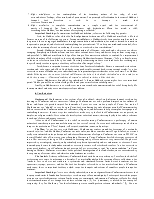



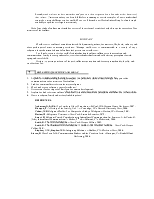













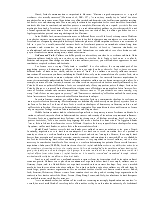














УО «Белорусский государственный экономический университет»
Факультет международных бизнес-коммуникаций
Кафедра делового английского языка
МАТЕРИАЛЫ ДЛЯ СЕМИНАРОВ
ПО ДИСЦИПЛИНЕ
«ТЕОРИЯ МЕЖКУЛЬТУРНОЙ КОММУНИКАЦИИ»
Для студентов 2 курса ФМБК
МИНСК 2009
CONTENTS
SEMINAR 1. NONVERBAL COMMUNICATION AND CULTURE…………………………………………. 3
SEMINAR 2. IDENTITY, STEREOTYPES AND PREJUDICES……………………………………………. 13
SEMINAR 3. THE IMPACT OF RELIGION, FAMILY AND HISTORY ON CULTURE AND COMMUNICATION ……………………………………………………………………………………………….21
SEMINAR 4. CONFLICT RESOLUTION IN VARIOUS CONTEXTS ……………………………………….33
SEMINAR 5. INTERCULTURAL COMMUNICATION IN BUSINESS ……………………………………...40
SEMINAR 6. INTERCULTURAL COMMUNICATION IN EDUCATION …………………………………..50
SEMINAR 7. FOLK AND POPULAR CULTURES IN THE CONTEXT OF INTERCULTURAL COMMUNICATION ………………………………………………………………………………………………58
SEMINAR 1
NONVERBAL COMMUNICATION AND CULTURE
* Verbal vs. nonverbal communication * What nonverbal behavior communicates * Functions of nonverbal communication * Guideline and limitations of nonverbal communication * Classifications of nonverbal communication by body behavior, space and distance, time, silence
Key words:
Appearance, attire, complementing, contradicting, distance, eye contact and gaze, facial expression, fight approach, flight approach, furniture arrangement, gestures, kinesics, nonverbal, paralanguage, regulating, seating, silence, space, substituting, time (M-time, P-time).
Comparing Verbal and Nonverbal Communication
Both verbal and nonverbal communication are symbolic, communicate meaning, and are patterned; that is, they are governed by rules that are contextually determined. Societies have different nonverbal languages, just as they have different spoken languages. However, some differences between nonverbal and verbal communication codes have important implications for intercultural interaction.
Let's look at some examples of these differences. The following incident occurred to an American visiting lecturer when she was new to Algeria. One day she stood at her balcony and waved to one of the young Algerian teachers, who was walking across the school yard. Two minutes later, the young teacher knocked on the door and looking expectantly at her. Because the American professor knew that it was uncommon in Algeria for men to visit women they didn't know well, she was confused. Why had he come to her door? Was it because she was foreign? After a few awkward moments, he left. In Algeria (as in many other places), the U.S. "wave" is the nonverbal signal for "come here." The young teacher had assumed that the lady had summoned him to her apartment. As this example illustrates, rules for nonverbal communication vary among cultures and contexts.
Let's consider another example. Two U.S. students took a train from France to Germany. The conductor walked into their compartment and told them in English to take their feet away from the opposite seat. How had he known that they spoke English? As this example shows, nonverbal communication entails more than gestures. Even our appearance can communicate loudly. As this example shows, nonverbal behavior operates at a subconscious level. We rarely think about the way we stand, the hand gestures we use, and so on. Occasionally someone points out such behaviors, which brings them to a conscious level.
When misunderstandings arise, we are more likely to question our verbal communication than our nonverbal communication. We can search for a different way to explain verbally what we mean. We can look up words in a dictionary or ask someone to explain unfamiliar words. By contrast, it is more difficult to identify nonverbal miscommunications or misperceptions.
Learning Nonverbal Behavior. Whereas we learn rules and meanings for language behavior in grammar and language arts lessons, we learn nonverbal meanings and behaviors by more implicit socialization. No one explains, "When you talk with someone you like, lean forward, smile, and touch the person frequently, because that will communicate that you really care about him or her."
Sometimes, however, we learn strategies for nonverbal communication. Have you ever been told to shake hands firmly when you meet someone? You may have learned that a limp handshake indicates a weak person. Likewise, many young women learn to cross their legs at the ankles and keep their legs together when they sit. These strategies combine socialization and the teaching of nonverbal codes.
Coordinating Nonverbal and Verbal Behaviors. Nonverbal behaviors can reinforce, substitute for, or contradict verbal behaviors. When we shake our heads and say "no," we are reinforcing verbal behavior. When we point instead of saying "over there," our nonverbal behavior is substituting for our verbal communication. If we tell a friend, "I can't wait to see you," and then don't show up at the friend's house, the nonverbal behavior is contradicting the verbal behavior. Because nonverbal communication operates at a less conscious level, we tend to think that people have less control over their nonverbal behavior. Therefore, we often think of nonverbal behaviors as the "real" message.
Уважаемый посетитель!
Чтобы распечатать файл, скачайте его (в формате Word).
Ссылка на скачивание - внизу страницы.